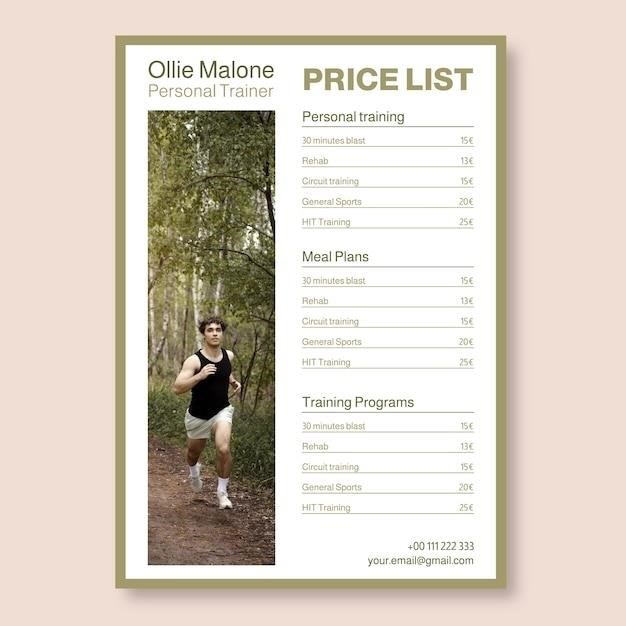programme course à pied débutant pdf
Programme Course à Pied Débutant PDF⁚ A Complete Guide
This comprehensive guide offers a beginner-friendly running program in PDF format designed to help you start your running journey with confidence. Whether you’re aiming to lose weight, improve your fitness, or simply enjoy a new activity, this program provides a structured approach to help you reach your goals.
Introduction
Embarking on a running journey can be both exhilarating and daunting, especially for beginners. The prospect of lacing up your shoes and hitting the pavement can be overwhelming, but with the right guidance and a structured approach, you can transform from a couch potato to a confident runner. A beginner-friendly running program, often presented in a convenient PDF format, provides the perfect roadmap to navigate your initial steps into the world of running. This guide is specifically tailored for those who are new to running or returning after a break, offering a gradual progression that minimizes the risk of injury and maximizes enjoyment.
Imagine yourself effortlessly gliding through parks, feeling the wind in your hair, and experiencing the rush of endorphins as you conquer each stride. This isn’t just a dream; it’s a tangible goal within reach with a well-designed beginner running program. These programs typically incorporate a mix of running and walking intervals, gradually increasing the duration and intensity of runs over time. You’ll learn proper running form, discover essential gear, and gain valuable insights into nutrition, hydration, and injury prevention.
Whether you’re aiming to shed pounds, improve cardiovascular health, or simply enjoy the outdoors, a beginner running program can be your trusted companion. This guide will delve into the benefits of running for beginners, provide essential tips for getting started, and outline a comprehensive training plan that sets you up for success. So, lace up your shoes, embrace the journey, and get ready to discover the transformative power of running.
Benefits of Running for Beginners
Running, often perceived as a challenging activity, offers a plethora of benefits that extend far beyond physical fitness. For beginners, the rewards of embracing this sport can be truly transformative, both physically and mentally. Running can be a gateway to a healthier and happier lifestyle, empowering you to achieve personal goals and unlock your full potential.
One of the most compelling benefits of running is its impact on cardiovascular health. Regular running strengthens your heart and lungs, improving blood circulation and reducing the risk of heart disease, stroke, and other chronic conditions. As you build endurance, you’ll notice an increase in energy levels, enabling you to tackle daily tasks with greater ease and vitality. Running also plays a significant role in weight management, boosting your metabolism and helping you burn calories effectively.
Beyond physical benefits, running has a profound effect on mental well-being. The rhythmic motion and fresh air can be incredibly therapeutic, reducing stress, anxiety, and depression. Running can serve as a form of meditation, providing a much-needed escape from the daily grind and promoting a sense of peace and clarity. It’s a powerful tool for boosting self-esteem and confidence, as you witness your body and mind grow stronger with each run. As you progress, you’ll experience a sense of accomplishment and pride, knowing you’ve overcome challenges and achieved your goals.
Getting Started⁚ Essential Gear and Preparation
Before you embark on your running journey, it’s essential to equip yourself with the right gear and prepare your body for the challenge ahead. Investing in quality running shoes is paramount, as they provide support, cushioning, and protection for your feet and ankles. Choose shoes that fit comfortably and offer a good fit for your foot type and running style. Consider visiting a specialty running store for professional advice and gait analysis.
In addition to shoes, you’ll need comfortable running clothes that allow for freedom of movement and breathability. Opt for moisture-wicking fabrics that help keep you dry and cool during your runs. Invest in a good sports bra for added support, particularly if you’re a woman.
Before you start running, it’s crucial to prepare your body gradually. Begin with short walks to build your endurance and strengthen your muscles. Incorporate light exercises such as squats, lunges, and core work to enhance your lower body strength and stability. Consult a healthcare professional to rule out any pre-existing conditions and receive personalized advice for your training.
Remember, consistency is key to success. Start with a realistic training plan and gradually increase your mileage and intensity. Listen to your body and take rest days when needed. With proper preparation and a positive mindset, you’ll be well on your way to achieving your running goals.
Creating a Running Schedule
A well-structured running schedule is essential for progress and injury prevention. Start with a plan that fits your current fitness level and gradually increases your mileage and intensity over time. Aim for consistency, running 2-3 times a week, and prioritize rest days to allow your body to recover.
Your schedule should incorporate a mix of running and rest days, ensuring you have adequate time for muscle recovery and injury prevention. Consider alternating between longer runs, shorter interval training sessions, and cross-training activities like swimming or cycling.
When creating your schedule, be realistic about your time commitments and goals. If you’re new to running, start with short runs and gradually increase the duration and intensity. Prioritize quality over quantity, focusing on maintaining a comfortable pace and proper form.
It’s important to be flexible and adapt your schedule as needed. If you’re feeling tired or sore, take a rest day or shorten your run. If you’re feeling motivated and energetic, you can increase your mileage or intensity. Remember, consistency and gradual progression are key to building endurance and enjoying your running journey;
Warm-up and Cool-down Routines
Warm-up and cool-down routines are crucial for preventing injuries and enhancing performance. A proper warm-up prepares your body for the demands of running by increasing blood flow, loosening muscles, and improving flexibility. It typically involves light cardio, like walking or jogging, followed by dynamic stretching, such as arm circles, leg swings, and torso twists.
A cool-down helps your body recover from the exertion of running by reducing muscle soreness and preventing stiffness. It involves light cardio, such as walking or slow jogging, followed by static stretching, holding each stretch for 15-30 seconds.
Examples of warm-up exercises include high knees, butt kicks, arm circles, and leg swings. Cool-down exercises might include quad stretches, hamstring stretches, calf stretches, and chest stretches.
Remember to listen to your body and adjust your warm-up and cool-down routines as needed. If you’re feeling tight or sore, spend extra time stretching. If you’re feeling energetic, you can shorten your warm-up and cool-down. The key is to make sure you’re properly prepared for your run and allowing your body to recover afterward.
Training Plan for Beginners
A beginner-friendly training plan should focus on gradual progression, allowing your body to adapt to the demands of running. A typical plan might involve alternating running and walking intervals, gradually increasing the running time and decreasing the walking time over time. This approach helps build endurance and prevents injuries by avoiding excessive stress on your muscles and joints.
For instance, you could start with a 30-minute workout consisting of 5 minutes of walking, followed by 3 minutes of running, then 2 minutes of walking, repeating this cycle for the duration of the workout. Over the weeks, you can gradually increase the running time to 4 minutes, then 5 minutes, and so on, while decreasing the walking time accordingly.

The specific details of your training plan will depend on your current fitness level, goals, and preferences. It’s important to listen to your body and adjust the plan as needed. If you feel overwhelmed, take a rest day or reduce the intensity of your workout. If you feel strong and capable, you can increase the intensity or duration.
Consistency is key to success in any training program. Aim to run at least three times a week, and gradually increase your running time and distance as you progress. With patience and persistence, you can achieve your running goals and enjoy the many benefits of this rewarding activity.
Important Considerations for Beginners
Starting a running program requires careful consideration to ensure a safe and enjoyable experience. One crucial aspect is choosing the right running shoes. Proper footwear provides support, cushioning, and stability, minimizing the risk of injuries. Visit a specialty running store for a professional fitting, taking into account your foot type, gait, and running style.
Another essential factor is listening to your body. Don’t push yourself too hard, especially when starting. Gradually increase your running time and distance to avoid overexertion and potential injuries. Rest and recovery are equally important, allowing your body to adapt and rebuild. Ensure adequate sleep, hydration, and proper nutrition to support your training.
Staying motivated is key to long-term success. Find a running buddy or join a running group for support and encouragement. Set realistic goals and celebrate your achievements along the way. Track your progress, noting your distance, pace, and how you feel during your runs. This information can help you monitor your progress and adjust your training plan as needed.
Remember, running is a journey, not a race. Enjoy the process, listen to your body, and stay committed to your goals. With dedication and a positive attitude, you can achieve your running aspirations and experience the transformative benefits of this healthy and rewarding activity.
Nutrition and Hydration
Proper nutrition and hydration are essential for optimal performance and recovery during your running journey. Fueling your body with the right nutrients before, during, and after runs is crucial for sustained energy and muscle repair. Prioritize a balanced diet rich in carbohydrates for energy, proteins for muscle building, and healthy fats for overall well-being.
Before your runs, consume a light meal or snack that provides sustained energy, such as whole-grain toast with peanut butter or a banana with yogurt. During longer runs, consider consuming energy gels or sports drinks to replenish electrolytes and prevent dehydration. After your runs, refuel with a protein-rich meal or snack to aid muscle recovery.
Staying hydrated is equally important, as running can lead to significant fluid loss. Drink plenty of water throughout the day, especially before, during, and after your runs. Listen to your body and drink water when you feel thirsty. You can also consider incorporating electrolyte-rich sports drinks, especially during longer runs or in hot weather.
Pay attention to your body’s signals and adjust your nutrition and hydration strategies as needed. By prioritizing proper nutrition and hydration, you can enhance your running performance, speed up recovery, and optimize your overall health and well-being.
Avoiding Injuries
Preventing injuries is a crucial aspect of any running program, especially for beginners. As your body adapts to the demands of running, it’s essential to take precautions to minimize the risk of overuse injuries. Start gradually, increasing your mileage and intensity progressively over time. Listen to your body and rest when needed, allowing for adequate recovery between runs.
Proper warm-up and cool-down routines are essential for preparing your muscles for activity and aiding in recovery. Before each run, engage in dynamic stretches like leg swings, arm circles, and torso twists to activate your muscles and improve flexibility. After your run, perform static stretches, holding each stretch for 30 seconds to improve range of motion and reduce muscle soreness.
Wear appropriate running shoes that provide adequate support and cushioning. Consult with a running specialist to find shoes that fit your foot type and running style. Invest in quality running gear that fits well and minimizes friction or chafing. Additionally, prioritize proper form and running technique to minimize stress on your joints and muscles.
Remember, running is a gradual process, and patience is key. Avoid pushing yourself too hard too soon, and allow your body to adapt to the new demands. By incorporating these preventive measures, you can significantly reduce your risk of injuries and enjoy a safe and sustainable running journey.
Progress Tracking and Motivation
Tracking your progress is essential for staying motivated and celebrating your achievements as you embark on your running journey. A simple running log can be a valuable tool for monitoring your distance, pace, and time. Noting down your runs helps you visualize your improvements and identify areas for growth.
Set realistic goals that are achievable and inspire you to keep going. Instead of focusing solely on speed or distance, consider setting goals related to consistency, enjoyment, or overcoming personal challenges. Celebrate your milestones, no matter how small they may seem. Reward yourself for your dedication and commitment to your running journey.
Finding a running buddy can provide motivation and accountability. Sharing your goals and progress with a friend can create a supportive environment and encourage you to push your limits. Join a running club or group to connect with other runners and benefit from shared experiences.
Listen to your body and be kind to yourself. There will be days when you don’t feel like running. Don’t be afraid to take a break or modify your routine; Remember that consistency is key, and even small steps forward contribute to your overall progress. Enjoy the journey and celebrate your achievements along the way.



